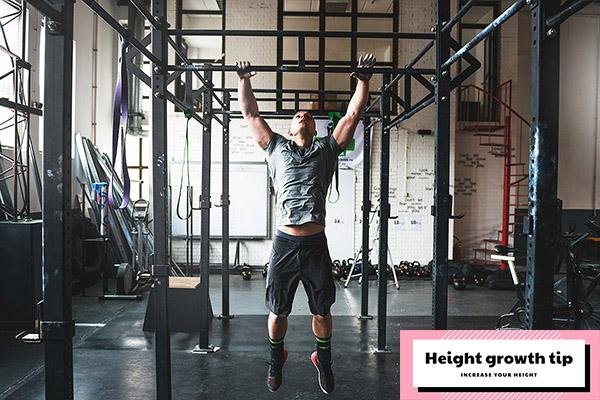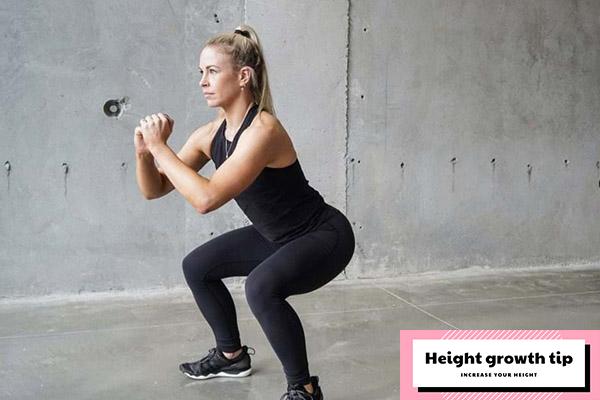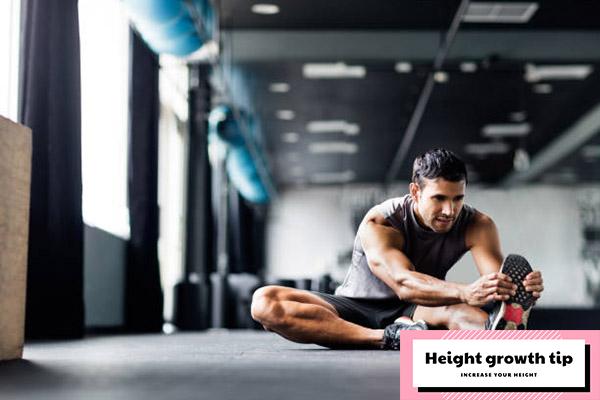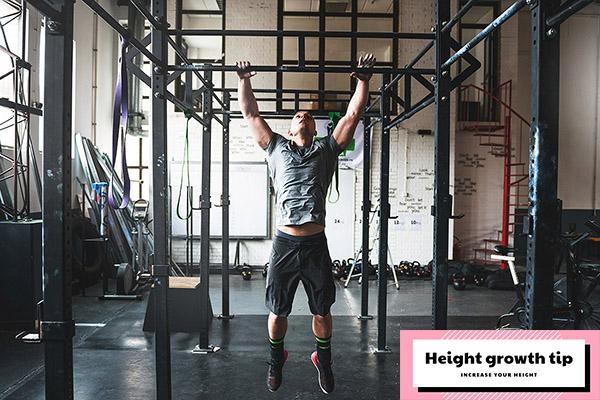Does exercising increase your height?

There is a widespread misconception circulating regarding the potential of specific stretching exercises to unlock an individual’s hidden height potential. This belief, harbored by some, suggests that engaging in activities such as climbing, hanging, swimming, or even utilizing an inversion table can work some miraculous growth magic, adding precious inches to one’s stature.
But the truth of the matter is far more nuanced. While it is indeed accurate that being tall and engaging in physical activities can aid children and teenagers in maximizing their potential height, the same cannot be said for adults. The key player in height growth lies in the growth plates – these are soft, cartilaginous tissues located at the ends of long bones such as the humerus and femur. These growth plates remain open during the formative years, and when the body releases human growth hormone (HGH) in response to physical activity, it serves as a signal for these bones to lengthen. Furthermore, new bone material is continually added to the epiphyseal plates situated at the extremities of these bones, leading to significant height gains during growth spurts, particularly during puberty.
However, once puberty reaches its conclusion, the bones undergo a process called ossification, and the epiphyseal plates close permanently. At this juncture, the prospect of further height augmentation becomes highly improbable. Consequently, even if exercise triggers a surge in HGH levels among adults, the resulting effect on height is unlikely to be substantial. Nevertheless, it is worth noting that certain exercises can genuinely improve one’s posture. Given that many adults struggle with poor posture, maintaining an upright stance can create the illusion of increased height.
In summary, while exercise offers a myriad of benefits for overall health and posture, it falls short in its capacity to significantly alter the height of adults once the growth plates have firmly sealed shut
What is the Ideal Age to Begin an Exercise Routine?
Determining the perfect age to embark on a fitness journey is a nuanced decision, influenced by a multitude of factors, including the type and intensity of exercise, as well as individual considerations such as physical development and overall health. Below, we present comprehensive guidelines spanning various age groups:
- Early Childhood (Ages 3 to 5): During this crucial developmental phase, it is advisable for children to engage in unstructured physical activities aimed at enhancing their gross motor skills. Activities such as running, jumping, climbing, and interactive games contribute to physical growth, rendering formal exercise programs unnecessary.
- Middle Childhood (Ages 6 to 12): This pivotal period calls for the introduction of structured physical activities, organized sports, and recreational games. Encouraging children to explore sports or activities that capture their interest is essential for honing fundamental movement skills and improving coordination.
- Adolescence (Ages 13 to 17): Adolescence marks a significant stage for exercise due to pronounced bodily changes. Consistent engagement in physical activity, participation in sports, and supervised strength training can support healthy development and enhance bone density.
- Adulthood (Ages 18 and above): Maintaining a consistent exercise routine throughout adulthood is crucial for overall well-being, weight management, and reducing the risk of chronic health conditions. Developing a personalized exercise regimen that aligns with individual goals and preferences is key.
- Older Adults (Ages 65 and above): The adage “it’s never too late to start” holds true for older adults. Low-impact exercises such as walking, swimming, or practicing tai chi can play a vital role in preserving mobility, balance, and overall vitality.
Regardless of the age at which one begins their fitness journey, it is essential to exercise caution and consider existing health conditions or physical limitations. Any concerns should prompt consultation with a healthcare professional or fitness expert to determine the most suitable exercise plan.
In all cases, safety should be the top priority. Exercise routines should be appropriate for one’s age, enjoyable, and tailored thoughtfully to their unique fitness level and capabilities.
Is It Better to Exercise in the Morning or Evening for Height Gain?
The question of whether morning or evening workouts can contribute to increased height is a common one. However, it’s important to understand that neither morning nor evening exercise is likely to have a significant impact on your height, especially if your growth plates have already closed, which typically occurs after puberty.
Height is primarily determined by genetic factors and the presence of growth plates in your bones, which allow for bone elongation during growth periods. Once these growth plates fuse, usually after puberty, no exercise regimen can substantially increase your height.
However, exercise remains invaluable for overall health and well-being. While it cannot change your bone length or make you taller beyond your genetic potential, regular physical activity can significantly improve your posture. Improved posture can create the illusion of increased height, especially if you’ve been slouching or not maintaining proper posture. Nevertheless, it’s essential to remember that this won’t actually change your physical height.
In summary, exercise is essential for its numerous health benefits and overall wellness, but it should not be expected to increase your height once your growth plates have closed.

Which exercises are most effective for increasing height?
Enhancing one’s height through exercise is a quest many individuals embark upon, seeking to unlock their full growth potential. Engaging in the right exercises can wield a profound impact, not only by toning muscles but also by stimulating the release of growth hormones. Here, we present a selection of six exercises, each accessible without the need for specialized equipment or assistance. The regular inclusion of these exercises within your fitness regimen has the potential to add precious inches to your stature.
1. Hanging Bars:
Hanging from a horizontal bar presents a straightforward yet highly effective method to counteract the relentless force of gravity on your height. By elongating and decompressing the joints and spine, you can alleviate the compression of cartilage and stimulate height gain. During hanging, it’s essential to ensure the bar is positioned at a height that permits full extension without ground contact. If necessary, you can bend your knees while suspended. Maintain your palms facing outward and relax your shoulders and hips to allow gravity to gently elongate your body.
2. Cobra Stretch:
The cobra stretch places particular emphasis on the upper body, especially the spine, enhancing flexibility and fostering an upright posture. To execute this exercise:
- Begin by lying on your stomach with legs fully extended.
- Position your hands beneath your shoulders, palms firmly planted on the floor.
- Gradually elevate your head and chest away from the floor, arching your back to its maximum extent.
- Maintain this position for 10-15 seconds.
- Relax and return to your initial position.
- Repeat this stretch ten times for three sets
3. Squat Jump:
Exercises that involve jumping, such as squat jumps, serve to fortify lower body muscles and joints, potentially contributing to height augmentation. These exercises concurrently enhance flexibility and foster explosive strength.
- Begin with feet shoulder-width apart and arms at your sides.
- Maintain an upright posture with a straight back and chest elevated as you squat down.
- Propel yourself upwards by pushing through the balls of your feet, employing your thigh muscles as springs.
- Execute a powerful vertical jump.
- Upon landing, cushion the impact by immediately returning to a squat position, and then jump again
4. Swimming:
Regular swimming holds the potential to alleviate spinal pressure and encourage height growth. It gently stretches tendons, joints, and ligaments in the arms, legs, and back. For optimal height benefits, engage in swimming sessions lasting between 30 minutes to 1 hour, at least four or five days a week.
If swimming is not a viable option, consider the dry land swimming exercise known as alternate kick, which primarily targets the strengthening and toning of the lower back.
- Begin by lying on your stomach, fully extending your body.
- Simultaneously lift your right arm and left leg a few inches off the floor while keeping your knees straight.
- Maintain this position for a few seconds.
- Return to the starting position and repeat the process, this time with your left arm and right leg
5. Basketball:
Engaging in basketball entails a diverse range of movements targeting all major muscle groups, potentially contributing to height increase. The jumping and anaerobic exercises intrinsic to basketball can stimulate muscle growth and prompt the release of growth hormones from the pituitary gland. Furthermore, the game enhances focus and facilitates improved blood circulation throughout the body.
6. Toes Touch (Standing and Sitting):
To bolster flexibility and elongate the spine, consider these fundamental toe touch exercises:
Standing Toe Touch:
- Stand with your feet hip-width apart.
- Gradually bend forward, reaching for the floor with your fingertips or palms.
- Maintain this position for 5 seconds before returning to the upright stance.
- Repeat this exercise approximately 15 times.
Sitting Toe Touch:
- Sit on the floor with your legs fully extended in front of you.
- Bend forward, extending your arms until they touch your feet.
- Hold this position for 5 seconds before returning to the starting position.
- Repeat this exercise around 15 times.
Incorporating these exercises into your fitness routine and practicing them consistently may pave the way for achieving your height aspirations over time.

What actions should you take while engaging in physical activity?
Achieving a successful and rewarding exercise routine involves a multifaceted approach that aligns with your fitness goals and promotes your overall well-being:
- Choose the Right Attire: When embarking on your fitness journey, carefully select clothing that provides both comfort and flexibility. Loose-fitting attire allows unrestricted movement and helps dissipate body heat during your workout.
- Create a Comprehensive Fitness Plan: To prevent boredom and reduce the risk of injuries, develop a fitness program that includes a variety of activities. Embrace cardio workouts, strength training, flexibility exercises, and other physical pursuits to add diversity to your routine.
- Prioritize the Warm-Up: Always begin your exercise routine with a well-structured warm-up session. This practice prepares your muscles and cardiovascular system for the upcoming intensity, significantly reducing the likelihood of injuries.
- Start Gradually and Progress Slowly: Whether you’re new to exercise or starting a new fitness plan, begin with low-intensity activities. Gradually increase the intensity and duration over time. This gradual approach protects against overexertion and potential injuries.
- Focus on Controlled Breathing: During your workout, concentrate on maintaining a steady and controlled breathing pattern. This mindful breathing enhances oxygen delivery to your muscles, ultimately improving endurance and performance.
- Stay Well-Hydrated: Hydration is crucial—make sure you consume enough water before, during, and after exercise. This not only prevents dehydration but also reduces the risk of heat-related illnesses.
- Finish with a Cool-Down and Rest: After each workout session, incorporate gentle exercises and stretching into your routine to help your body return to its normal state. Allow yourself adequate rest and recovery time between intense workouts to promote muscle repair and growth.
- Fuel Your Body with a Balanced Diet: Following your exercise routine, replenish your energy stores and support muscle recovery with a well-rounded meal. Choose a post-workout meal that includes essential elements like protein, carbohydrates, and healthy fats.
In conclusion, while regular and appropriate exercise can contribute to gradual height enhancement, it should be complemented by a balanced diet and proper nutrition to effectively promote overall bodily growth and strengthen the immune system. Establishing a consistent daily exercise routine from a young age can serve as a catalyst for height augmentation while simultaneously enhancing overall health and vitality.

